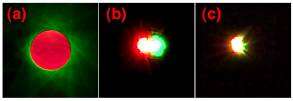Optical vortex could look directly at extrasolar planets

A new optical device might allow astronomers to view extrasolar planets directly without the annoying glare of the parent star. It would do this by "nulling" out the light of the parent star by exploiting its wave nature, leaving the reflected light from the nearby planet to be observed in space-based detectors. The device, called an optical vortex coronagraph, is described in the December 15, 2005 issue of Optics Letters.
These laboratory images demonstrate how the optical vortex coronograph works. They were obtained with a green "star" and red "planet" (point light sources). (a) shows how the green light is "spun out," while the red light remains unaffected. Images of the point sources are shown when large (b) and small (c) apertures are used to limit the transmission of light from (a). Reported by: Foo et al. in Optics Letters for 1 December 2005
About ten years ago the presence of planets around stars other than our sun was first deduced by the very tiny wobble in the star's spectrum of light imposed by the mutual tug between the star and its satellite. Since then more than 100 extrasolar planets have been detected in this way. Also, in a few cases the slight diminution in the star's radiation caused by the transit of the planet across in front of the star has been observed.
Many astronomers would, however, like to view the planet directly - a difficult thing to do. Seeing the planet next to its bright star has been compared to trying to discern, from a hundred meters away, the light of a match held up next to the glare of an automobile's headlight. The approach taken by Grover Swartzlander and his colleagues at the University of Arizona is to eliminate the star's light by sending it through a special helical-shaped mask, a sort of lens whose geometry resembles that of a spiral staircase turned on its side.
The process works in the following way: light passing through the thicker and central part of the mask is slowed down. Because of the graduated shape of the glass, an "optical vortex" is created: the light coming along the axis of the mask is, in effect, spun out of the image. It is nulled, as if an opaque mask had been place across the image of the star, but leaving the light from the nearby planet unaffected.
The idea of an optical vortex has been around for many years, but it has never been applied to astronomy before. In lab trials of the optical vortex mask, light from mock stars has been reduced by factors of 100 to 1000, while light from a nearby "planet" was unaffected. Attaching their device to a telescope on Mt. Lemon outside Tucson, Arizona, the researchers took pictures of Saturn and its nearby rings to demonstrate the ease of integrating the mask into a telescopic imaging system.
This is, according to Swartzlander, a more practical technique than merely attempting to cover over the star's image, as is done in coronagraphs, devices for observing our sun's corona by masking out the disk of the sun. It could fully come into its own on a project like the Terrestrial Planet Finder, or TPF, a proposed orbiting telescope to be developed over the coming decade and designed to image exoplanets.
Source: American Institute of Physics















